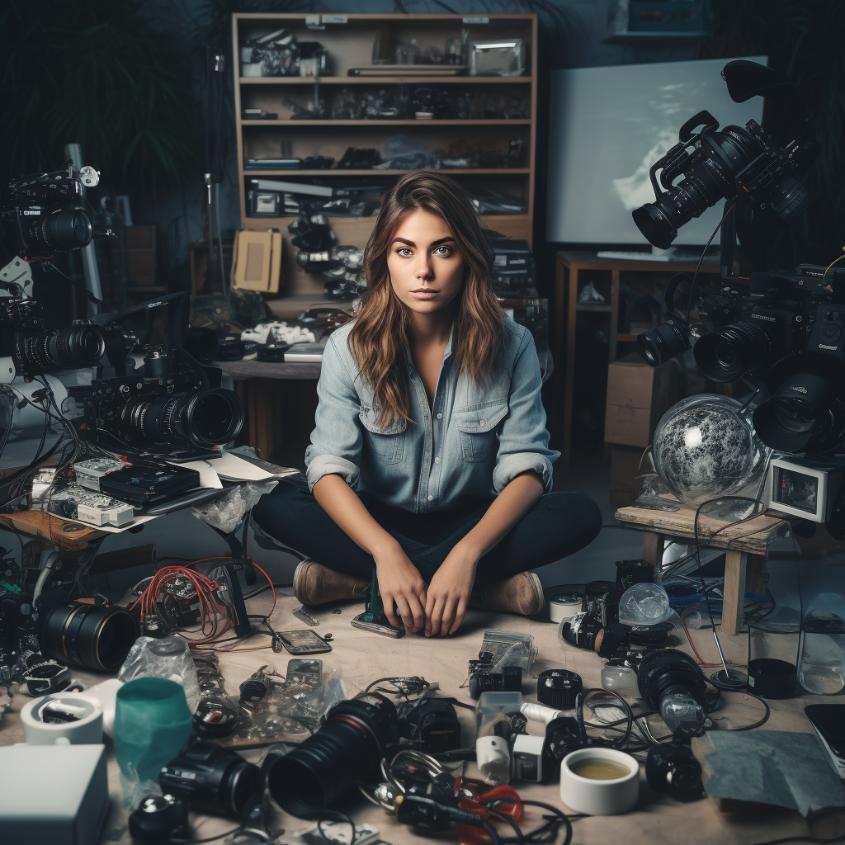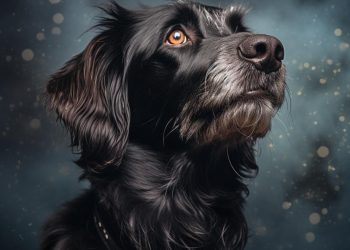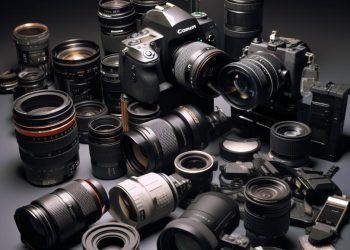Unit 3.3 IB Business Management
Unit 3.3 Costs and revenues
#1 JOANNE GOES PRO
Joanne had been a lifetime amateur photographer who studied photography and media at university. In her 3rd and final year, she started to wonder if she could make a living and become a professional photographer.
Whilst she was an amateur expert who loved sports and wildlife photography. She knew that she had no idea about starting a business. Joanne knew that she would be a sole trader, but she was concerned about finance. Joanne has limited sources of finance available and she is currently overdrawn on her current account!
However, Joanne does have a lot of the equipment needed already to work as a paid photographer!
Equipment owned already include: a professional camera (Nikon D6) and a variety of professional lenses (Nikon 50mm 1.4, Nikon 400mm 2.8, Nikon 10mm – 24mm f3.5) as well as a range of others. She also has a DJI Mavic drone, which she takes aerial photos and movies with!



Joanne was torn between two options! She thought about starting as a studio based photographer were customers would come to her for portraits!
But, she also acknowledged that this was a more expensive route than taking photos at weddings and for corporate events! She also freely admits that she loves the idea of a studio, but is aware that demand for studio photographs has fallen in recent years! She also knows that she prefers the variety of being in different locations and worries about the complexity of running her own studio. Joanne admits that she is not the most organized person!
Joanne anticipated her costs for both options and can be seen below
Option A: Studio photographer

Option B: No studio

#1 QUESTIONS: JOANNE GOES PRO
- Explain whether or not Joanne would be eligible for a bank loan? (Go online and find out the value of her current photographic equipment to help you answer this question)! [4]
- Calculate the total annual costs for Option A (studio photographer) [3]
- Calculate the total annual costs for Option B (non-studio photographer) [3]
- Which option (A or B) carries the greatest risk for Joanne in terms of setting up her business? [2]
- 5.) Categorise the costs from Option A into either fixed, variable, direct and indirect [14]
- Suggest what sorts of issues you think that Joanne might encounter in her first year of trading as a photographer? [6]
#2 JOANNE CONSIDERS HER REVENUE
Joanne has decided to target different markets within photography because she has the skills. She was also told that you should do a range of things to ‘spread the risk’. Joanne will generate different revenue streams by offering the following services to her clients:
- Wedding photography
- Corporate photography
- Aerial photography (using her drone)
- Making promotional movies using her drone for companies
- Baby portraits
Joanne has the following revenue projections for the first year of trading.
- Wedding photography: 10 weddings charging $3200 each
- Corporate photography: 15 contracts charging $2200 each
- Aerial photography using a drone: 10 contracts charging $3400 each
- Making promotional company movies using her drone: 4 contracts charging $4800 each
- Baby portraits: 10 contracts charging $195 each

Spreading yourself too thin
Joanne had the skills to offer these five revenue streams, but was concerned about trying to do too much in her first year! She decided to drop one revenue stream, but struggled to work out which was best to drop!
To help her, she thought about the costs of each stream, but also the time involved and came up with the following

- Calculate the total value of revenue for each of the five revenue streams [5]
- Calculate Joannes total projected revenue for the year across the five revenue streams [5]
- Suggest (based on the time, cost and revenue data) which revenue stream Joanne should drop [4]
- Discuss (with reference to the data you have calculated) whether Joanne should pursue Option A (studio photographer) or Option B (non-studio photographer) [10]
Costs and Revenues Info
Costs are the charges that an organization must pay from its operations. Some of these costs will be ‘one off’ costs and others will be ongoing costs.
In our example, the costs are related to a photographer establishing a business. However, a business making items may have other costs;
The purchase of raw materials for production
The purchase of stocks (inventory) in which to sell on
Rent to lease or hire a space.
A mortgage (a long term loan on property)
Insurance payments for public liability, buildings insurance and vehicle insurance
Salaries and / or wages paid to employees and workers
Utility bills like gas, water, electricity etc
Fixed costs are considered to be fixed as they do not vary in relation to output! However, management salaries for example are likely to change each year. However, when the original contract is signed (for example) the cost of management salaries will not change! This cost is, however, likely to rise in line with inflation or increase if the manager is particularly successful or is desired to stay within the company!
Similarly, insurance costs (premiums) may go up each year. Same again. At the time of signing the contract, the insurance premium will remain unaltered for the duration of a year.
Fixed costs (FC) is often referred to as total fixed costs (TFC). The line is horizontal when drawn on a graph.
Variable costs are those that change in direct proportion to the amount of units produced! When production increases, the costs increase with production.
Raw materials are the most obvious example of a variable cost. If you produce more jumpers, then you need more wool (raw materials) to complete the production.
Total variable costs are often known as (TVC). One a graph, the line is upward sloping, which indicates variable costs increase with output. The line starts at the origin (£0) as zero production leads to zero variable costs!
Total revenue is the money received (inflows) from sales or other means. Revenue is calculated by Price * Quantity (P*Q)
For Joanne, it is the total money made from her various revenue streams.
Average revenue is more difficult to calculate for businesses (like Joanne’s proposed business) because she is selling or offering more than one product (prints) and services (photoshoots).
The term revenue streams is commonly used. Some of the most successful businesses can generate multiple revenue streams, which is useful as it reduces the risk of being a single revenue business!
Other sources of revenue could include;
- Transaction fees (often charged by banks)
- Memberships fees (Netflix)
- Royalties (charged for playing a song)
- Merchandise sales (football club kit)
- Advertising revenues (football teams making deals with companies to have their names on shirts)
- Consultancy fees (architects who have meetings to discuss with clients)
- Dividends (from shares owned that pay a dividend)
- Interest (earned from holding cash in a bank account)
- Leasing charges (for hiring out vehicles or machinery)
- Recurring grants or subsidies from government
KEY TERMS
SUGGESTED ANSWERS
1.) Explain whether or not Joanne would be eligible for a bank loan? (Go online and find out the value of her current photographic equipment to help you answer this question)! [4]
The answer is uncertain. Her existing equipment is a significant asset to her, currently valued at between 9000 – 12,000 GBP.
However, whether or not the bank agrees that it is an asset that they would lend against is another matter!
The banks view on lending to Joanne could be swayed by
- The quality of her business plan
- Her previous financial history
- Her current credit score
- Whether anybody in her family is willing to underwrite her business and act as guarantor
- Economic climate (are the banks optimistic or pessimistic)
- Whether or not she is qualified and has a background in this sort of work
- The amount she is requesting and whether or not the bank deem it to be within her means to pay it back
2.) Calculate the total annual costs for Option A (studio photographer) [3]

3.) Calculate the total annual costs for Option B (non-studio photographer) [3]

4.) Which option (A or B) carries the greatest risk for Joanne in terms of setting up her business? [2]
It seems that as a new business owner, Joanne might be encouraged to keep her costs as low as possible to reduce the revenue she needs to generate in order to break even!
There is a difference in costs between the two options of 34,745-19,295 = 15,450 GBP!
This is significant and indicates, an extra 1287.50 GBP will have to be made to cover additional costs associated with a studio each month.
Risk also rises with increased borrowing, so if Joanne doesn’t have the additional money to start the business, then she may be forced to borrow! This equates to risk, especially as her business structure is most likely to be a sole trader, which carries unlimited liability!
Finally, there is no guarantee that demand for studio portraits will emerge and so this leaves a huge level of fixed costs that need to be generated from other sources!
5.) Categorise the costs from Option A into either fixed, variable, direct and indirect [14]
Studio rental (pcm): Category: Fixed Cost (Monthly)
Explanation: The cost remains constant regardless of the number of sessions or projects conducted in the studio.
Advertising (pcm): Category: Fixed cost
Explanation: Whilst advertising may vary, it has been allocated here as a fixed cost to spend each month!
Capital equipment (lights and studio fittings): Category: Fixed Cost (One-time) Explanation: Capital equipment costs are typically one-time investments and are considered fixed.
Furniture: Category: Fixed Cost
Explanation: The purchase of furniture is usually a one-time expense, making it a fixed cost.
Interior fit out: Category: Fixed Cost
Explanation: Similar to furniture, the interior fit-out costs are typically incurred as a one-time investment to set up the space.
Office supplies: Category: Fixed and Indirect costs
Explanation: Office supplies do not vary greatly and there use is not directly tied to the output
Website (design and build): Fixed and Indirect
Explanation: The cost of designing and building a website is a one-time investment.
Hosting an internet site (pcm): Category: Fixed and indirect. Explanation: The service is at a pre-agreed price. However, an argument could be made that the actual price may vary according to traffic! Primarily it is a fixed cost for the duration of one year!
Postage: Category: Variable and Indirect Cost
Explanation: Postage costs can vary based on the volume of mail and are considered an indirect cost.
Utility: Category: Fixed and indirect
Explanation: Utility costs in a business like these may vary slightly but are not connected to output!
Public liability insurance:
Category: Fixed and Indirect
Explanation: Insurance costs are typically fixed for a specific coverage period, often annually.
Travel costs (pcm): Category: Variable and direct
Explanation: Travel costs may vary each month based on the level of business-related travel.
Leasing a car (pcm): Category: Fixed Cost
Explanation: Leasing a car involves a fixed monthly payment for the lease term.
Memory cards: Category: Variable and Direct Cost
Explanation: The purchase of memory cards directly contributes to the production of photographs and can vary in quantity.
Internet connection (pcm): Category: Fixed Cost
Explanation: The cost of the internet connection is generally a fixed monthly expense.
6.) Suggest what sorts of issues you think that Joanne might encounter in her first year of trading as a photographer? [6]
A massive range of options are available that may create difficulties for new business owners. These range from difficulty finding customers, to negative online reviews to suddenly changing economic conditions.
- Competition already established in the market:
- Lack of available funds if she needed to borrow:
- Legal Structure and Registration:
- Personal Liability:
- Financial Management:
- Marketing and Branding:
- Client Acquisition and Retention:
- Time Management:
- Skill Development:
- Networking:
- Insurance and Risk Management:
- Client Contracts and Legal Protection:
- Technology Adoption:
- Market Research and Pricing:
- Taxation and Record Keeping:
- Work-Life Balance:
1.) Calculate the total value of revenue for each of the five revenue streams [4]

2.) Calculate Joannes total projected revenue for the year across the five revenue streams [4]
See above
3.) Suggest (based on the time, cost and revenue data) which revenue stream(s) Joanne should drop [6]

There are a number of ways to analyse this. The question is prompting you to use the forecasted data given to you to help Joanne make a decision about revenue streams. So, we need to have a look at firstly the data for revenue streams and perhaps rank them in order!
- Wedding photography
- Aerial photography
- Corporate photography
- Promotional movies
- Baby portraits
However, when we look at the average revenue per period time (or…..factor in how much time it takes Joanne to generate this revenue then the picture changes)!
- Promotional movies
- Aerial photography
- Corporate photography
- Wedding photography
- Baby portraits
The data reveals that there are three revenue streams that show very strong revenue generated per hour of Joanne’s time!
There are two outliers, which are way below the average, which are weddings and also baby portraits.
Remember that baby portraits would require a studio which contributes to a large amount of the initial costs for Joanne as well as yielding both the least revenue and the least revenue per period time! This is a strong case against offering baby portraits!
Which one to drop? The answer should really come from the quantitative analysis and explore ideas like, Joanne should maximise revenue per time period, she should seek to limit work that keeps her from doing other things (which weddings may do as they take so long). She could also consider, which work generates more future work (weddings or baby portraits). Because she is an enthusiastic photographer, she must also consider which she enjoys doing (as she needs to earn revenue, but must also enjoy her work)!
4.) Discuss which whether Joanne should pursue Option A (studio photographer) or Option B (non-studio photographer) [10]
The question can be answered in a variety of ways, but MUST always have the following elements:
Written into full sentences using appropriate terminology.
- Explore both options.
- Highlight advantages and disadvantages of each.
- You must make reference to the case study (application)
- Make a recommendation of which option she should chose!
- Caveat your recommendation as we cannot be sure that things will turn out as planned!
Suggested application points:
1.) Joanne has no passion for studio photography
2.) She has limited finance and is currently overdrawn!
3.) Revenue from studio portraits is not high, versus the cost of the studio!
4.) Joanne worries about running and a lack of organisational flair!
Some following points to consider:
Option A: Studio Photographer
Strengths:
- Professional Image: Having a studio may enhance Joanne’s professional image, providing a dedicated space for client meetings and portrait sessions.
- Controlled Environment: A studio provides a controlled environment for photography, allowing Joanne to manage lighting, backgrounds, and other factors more effectively.
- Diversification of Services: Offering portrait sessions in a studio allows Joanne to diversify her services beyond event and wedding photography and add another revenue stream!
Weaknesses:
- High Costs: Operating a studio incurs significantly higher costs, including rent, utilities, and maintenance. Joanne, being overdrawn on her current account, may struggle to afford these expenses.
- Limited Flexibility: A studio-based approach may limit Joanne’s flexibility in terms of location and availability. She may be tied to the studio and miss out on potential opportunities outside the studio setting.
Option B: Non-Studio Photographer
Strengths:
- Lower Costs: Operating without a studio significantly reduces overhead costs, allowing Joanne to operate with lower financial risk.
- Flexibility: Joanne can operate as a non-studio photographer, providing services at various locations such as weddings and corporate events. This flexibility may attract a broader range of clients.
- Utilization of Existing Equipment: Joanne already owns professional photography equipment, including a high-end camera and lenses. Operating without a studio allows her to utilize this equipment efficiently.
Weaknesses:
- Perceived Professionalism: Some clients may perceive non-studio photographers as less professional compared to those with dedicated studios. Joanne needs to manage this perception through strong branding and a portfolio that showcases her expertise.
- Limited Control: Without a studio, Joanne has limited control over the shooting environment, especially during outdoor events. Adverse weather conditions or other external factors may impact the quality of the photos.
Conclusion: Considering Joanne’s limited sources of finance and her current financial situation, Option B (non-studio photographer) seems more viable. The lower costs and increased flexibility align with Joanne’s circumstances. To address the perceived professionalism issue, Joanne can invest in building a strong brand image and an impressive portfolio that demonstrates her skills and versatility.
Overall, Joanne’s decision should prioritize financial feasibility, flexibility, and leveraging her existing equipment. The choice between studio and non-studio photography ultimately depends on her goals, target market, and risk tolerance.





